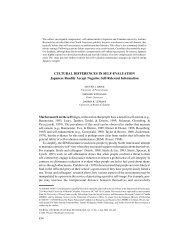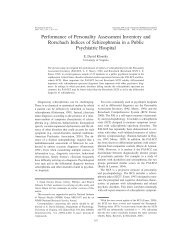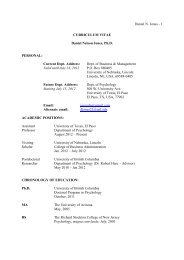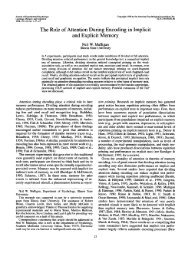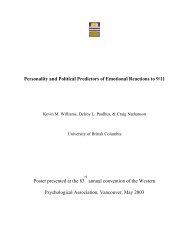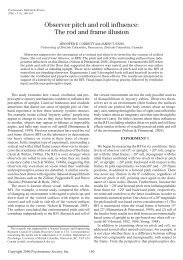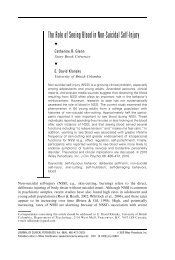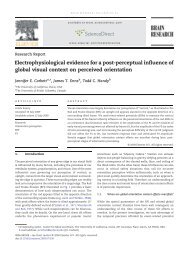Dynamic Social Impact and the Evolution of Social Representations ...
Dynamic Social Impact and the Evolution of Social Representations ...
Dynamic Social Impact and the Evolution of Social Representations ...
You also want an ePaper? Increase the reach of your titles
YUMPU automatically turns print PDFs into web optimized ePapers that Google loves.
Journal <strong>of</strong> Communication, Autumn I996<br />
group from ano<strong>the</strong>r (Ford & Stangor, 1992).<br />
Although this functional analysis does suggest that stereotypes based upon<br />
some descriptive difference between groups are more likely to be perpetuated<br />
than stereotypes that are clearly false, it does not imply that stereotypes must<br />
contain a kernel <strong>of</strong> truth. Many objectively false stereotypes <strong>of</strong> disadvantaged<br />
groups may be based in part on apparent (but not inherent) group differences<br />
in behavior, performance, or circumstances. In addition, because <strong>of</strong> psychological<br />
biases toward confirmation ra<strong>the</strong>r than disconfirmation <strong>of</strong> existing beliefs,<br />
many objectively untrue stereotypes fail to be extinguished even in <strong>the</strong> face <strong>of</strong><br />
overwhelming counterevidence.<br />
In order to be adaptive, a stereotypic belief must not only survive in an<br />
individual’s mind, but must replicate in <strong>the</strong> minds <strong>of</strong> o<strong>the</strong>r individuals. Stereotypic<br />
beliefs replicate through <strong>the</strong> processes <strong>of</strong> interpersonal communication,<br />
but not all stereotypic beliefs are equally likely to become part <strong>of</strong> social discourse.<br />
Whe<strong>the</strong>r a stereotypic trait is likely to be communicated depends, in<br />
part, on whe<strong>the</strong>r <strong>the</strong> trait is able to be communicated simply <strong>and</strong> efficiently,<br />
<strong>and</strong> whe<strong>the</strong>r it is perceived to be relevant <strong>and</strong> informative. Many negative or<br />
positive beliefs about individuals members <strong>of</strong> groups are likely to be based on<br />
gut reactions to behaviors or characteristics that are not consciously identifiable<br />
(Lewicki, 1985). Although <strong>the</strong>se Characteristics may be <strong>the</strong> locus <strong>of</strong> <strong>the</strong> emotional<br />
reaction, <strong>the</strong>se characteristics may not be communicated to o<strong>the</strong>rs, <strong>and</strong><br />
will not become central to cultural stereotypes. Instead, more reasonable-sounding<br />
characteristics will-even if <strong>the</strong>y are untrue. Perhaps even more important<br />
in influencing whe<strong>the</strong>r a stereotypic trait is replicated is whe<strong>the</strong>r it is believed<br />
to be informative or relevant (Grice, 1975). For instance, it is rarely ei<strong>the</strong>r informative<br />
or relevant to tell o<strong>the</strong>rs that men on average are taller or more slimhipped<br />
than women.<br />
Even successfully replicating <strong>and</strong> consensually held stereotypes may face<br />
pressures to change, however. Just as biological species may adapt to changing<br />
natural environments, cultural stereotypes may change in <strong>the</strong> face <strong>of</strong> fluctuations<br />
in <strong>the</strong> cultural environment. Members <strong>of</strong> negatively stereotyped groups<br />
may overcome stereotypic expectations in spectacular <strong>and</strong> salient ways; laws<br />
may be enacted that allow greater privilege to previously disenfranchised<br />
groups; perceivers may begin to have greater contact with members <strong>of</strong> stereotyped<br />
groups. Changes such as <strong>the</strong>se are usually assumed to form a necessary<br />
condition to <strong>the</strong> revision <strong>of</strong> stereotypic beliefs. The biological metaphor suggests,<br />
however, that wholesale revision may not occur. In adapting to changing<br />
environments, species are not simply replaced with a different species. Ra<strong>the</strong>r,<br />
speciation occurs, through which new species emerge in addition to <strong>the</strong> old<br />
ones. Similarly, it is likely that in response to a changing social reality, stereotypes<br />
will speciate as well. Old stereotypes are not likely to become extinct; instead,<br />
new stereotypic beliefs may emerge alongside <strong>the</strong> old ones.<br />
This last consideration implicates <strong>the</strong> importance <strong>of</strong> dynamic self-organizing<br />
processing not only in <strong>the</strong> evolution <strong>of</strong> social belief systems, but also in <strong>the</strong><br />
evolving structure <strong>of</strong> social space. Group stereotypes not only help people<br />
make sense <strong>of</strong> <strong>the</strong>ir social world, <strong>the</strong>y may also influence who talks to whom<br />
68



